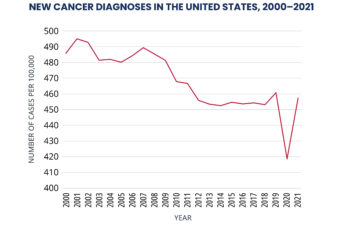
Justin Stebbing, Anglia Ruskin University
Eleven-time world champion and a six-time Olympic champion cyclist, Sir Chris Hoy has just revealed he has terminal prostate cancer aged just 48 years old.
It’s easy to assume that prostate cancer is a disease that only affects older men. But it can strike at any age, including younger and middle-aged men.
Although the average age of diagnosis is 68, about one in ten new cases are in men under 55. In fact, doctors have noticed more cases in younger men in recent years. If you’re in your 40s or 50s, it’s worth knowing about the risks and signs of prostate cancer.
When prostate cancer does occur in younger men, it tends to be more aggressive. If you’re diagnosed at a younger age, there’s a higher chance the cancer might be at a more advanced stage. This means it could be more dangerous than prostate cancer in older men. That’s why it’s crucial to catch it early if you can.
There are several signs that could point to prostate cancer. People affected might notice that they’re going to the bathroom more often, especially at night. Some people can have trouble starting or stopping when they pee, or their urine flow might be weak or stop and start.
Some men see blood in their urine or semen. Problems with erections, pain when you pee, or discomfort in your pelvic area are other possible signs.
If you notice any of these, it’s a good idea to talk to your doctor. Remember, these symptoms can be caused by lots of other conditions too, including being part of normal ageing, but it’s always best to get them checked.
Even if you don’t have symptoms, if you’re over 50, or over 45 with prostate cancer in your family, it’s worth having a chat with your doctor about prostate cancer screening. In this case, you might have heard of the PSA test. It’s a blood test that can help diagnose prostate problems, including cancer. But it’s not offered as a routine screening test for everyone.
Like a lot of diagnostic tests, the PSA test isn’t perfect. It can miss some cancers, and sometimes it says there might be cancer when there isn’t. This can lead to unnecessary worry and more tests. Also, it can’t tell the difference between slow-growing cancers that might never cause problems and more aggressive ones that need treatment. That’s why doctors suggest discussing it before deciding to have the test.
Sometimes there’s a genetic element to prostate cancers in younger people. There are genes that increase the risk of prostate cancer, and the same or similar genes increase the risk of other cancers like breast cancer.
If there are lots of men in your family affected by prostate cancer, or male relatives with breast cancer or younger people affected, it is worth having genetic tests to understand your own risk.
Sometimes people are even considered for a prostatectomy, which means a removal of one’s prostate, to decrease the risk of cancer occurring later on. In the future, these genetic tests will happen more and more, which is good news.
Overdiagnosis
One of the tricky things about prostate cancer screening is something called overdiagnosis. Many prostate cancers grow so slowly that they might never cause any problems. But once they’re found, men often want to treat them.
This can lead to side-effects that affect quality of life, even though the cancer itself might never have been harmful. That’s why doctors are careful about how they approach screening and diagnosis.
Some research suggests that just keeping an eye on things is better for elderly people, but this really isn’t the case for younger people.
You might be wondering about other tests for prostate cancer. The digital rectal exam, where a doctor checks your prostate with a gloved finger, used to be a common part of screening. These days, it’s not always considered necessary, especially if other tests like magnetic resonance imaging (MRI) scans are available.
MRI scans where you typically go in a narrow tube are being used more and more to look for prostate cancer. They can help find suspicious areas and guide biopsies if needed.
The first inkling Hoy had that something was wrong was when he developed shoulder pain, meaning the cancer had already spread. We do see this as oncologists, but in most cases, it’s localised to the prostate gland in the pelvis.
If you are diagnosed with prostate cancer, there are an increasing number of treatment options available. These might include keeping a close eye on slow-growing cancers without immediate treatment, surgery to remove the prostate, radiation therapy, hormone therapy, or chemotherapy for advanced cases.
We also have targeted drugs taken as tablets now too. The best choice depends on things like your age, how advanced the cancer is, and your overall health.
You might have heard that more men die with prostate cancer than from it. While this is true, it doesn’t mean you should ignore any concerns you have. Early detection and treatment can be crucial, especially for more aggressive cancers.
If you’re worried about any symptoms or about your risk of prostate cancer, don’t hesitate to talk to your doctor. Being proactive about your health is important. Remember, many men diagnosed with prostate cancer go on to live long, full lives, especially when it’s caught early.
Justin Stebbing, Professor of Biomedical Sciences, Anglia Ruskin University
This article is republished from The Conversation under a Creative Commons license.
Read the original article.


